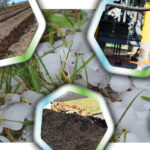
Nora Goldstein
BioCycle March/April 2015
BioCycle magazine is in its 56th year of publication. And 2015 marks the 45th year of BioCycle Conferences. Our longevity is due in large part to a belief that we are on the right track, which is bolstered by the existence of a thriving organics recycling industry. This is not to say that our persevering industry has seized the proverbial golden ring. But it does validate that by sticking to our guns, and focusing on not only being waste managers but — and these days, perhaps more importantly — being manufacturers of high value products, are paying off. One key reason is that these high value, sustainably manufactured products are tools to achieving climate resiliency, especially for food, water, energy and soil security.
Two recent New York Times articles discuss realities that drive this point home. “The Southwestern Water Wars” (3/13/15) highlights a “triple threat” across Texas and the Southwest: “Booming population, looming drought and the worsening effects of climate change.” The article provides a historical perspective about how civilization can’t survive when water runs out, and cautions that simply robbing Peter (small towns and rural areas that have water) to quench the thirst of Paul (rapidly growing metro areas) is not sustainable.
“As California Drought Enters 4th Year, Conservation Efforts and Worries Increase” (3/17/15) offers a grim prognosis in terms of water replenishment during the official rainy season — December through April — and notes that “California is facing a punishing fourth year of drought.” Inadequate precipitation combined with the winter of 2014 being “the hottest year on record for California” caused premature melting of the snowpack, which is counted upon to refill the reservoirs. State regulators voted to impose a new round of water conservation rules, and the president of the California Farm Bureau estimates that well over a million acres may go unplanted in 2015.
These realities highlight the nation’s (and countries relying on U.S. exports) vulnerability in terms of food, water and soil security — and the role that organics recycling and its high value end products play in reducing that vulnerability. (Ads on TV tell us not to worry about energy security, but food, water and soil security concerns (and energy) can be addressed via anaerobic digestion and digestate utilization, especially in the agricultural sector.) Compost is a case in point. Utilizing it in agriculture helps conserve moisture and can increase crop yields. Using compost in green infrastructure BMPs helps recharge groundwater when it rains, and soil is better able to retain moisture, which can help landscape survival (a very important fact in light of watering restrictions).
This brings me back to why we are on the right track. As you page through the BioCycle West Coast Conference Preview starting on page 25, you will see “ready to roll” solutions to many of these critical problems. For example, “A Path To Sustainable Infrastructure Solutions” by Conference Keynote Rhys Roth is chock full of strategies that don’t require robbing Peter to pay Paul, but instead, have Peter and Paul collaborating to provide critical municipal services. “Wasted Food Pilots Raise Consumer Awareness” features the Food: Too Good To Waste program led by Conference Keynote Ashley Zanolli of U.S. EPA. Teaching households how to prevent wasting food is essential, especially as pressure grows on agricultural producers (and may likely lead to price increases in some foods).
A BioCycle’s 29th Annual West Coast Conference, April 13-16, 2015 in Portland, Oregon will provide an opportunity to learn and network first hand with practitioners, policy makers, educators, equipment and service suppliers, advocates and others across the climate resiliency and organics recycling spectrum who reinforce our belief that we are on the right — and fast — track.









